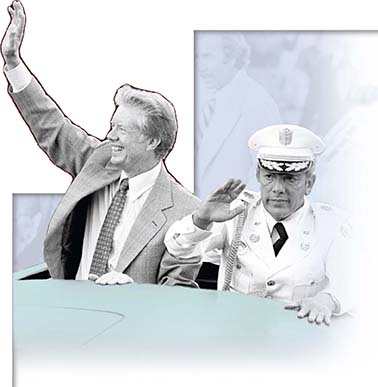SECTION 3: Foreign Policy Troubles

▲ President Carter and Panama’s leader General Omar Torrijos in 1978
WITNESS HISTORY  AUDIO
AUDIO
Human Rights and American Foreign Policy
As President, Jimmy Carter sought to center America’s foreign policy on human rights rather than on anticommunism. Carter outlined his views in 1977:
“For too many years, we’ve been willing to adopt the flawed and erroneous principles and tactics of our adversaries, sometimes abandoning our own values for theirs. We’ve fought fire with fire, never thinking that fire is better quenched with water…. [I] believe that it is a mistake to under-value the power of words and of the ideas that words embody.”
—President Jimmy Carter, Commencement Address at Notre Dame University, 1977
Objectives
- Compare the policies of Gerald Ford and Jimmy Carter toward the Soviet Union.
- Discuss changing U.S. foreign policy in the developing world.
- Identify the successes and failures of Carter’s foreign policy in the Middle East.
Terms and People
- Helsinki Accords
- human rights
- SALT II
- boat people
- sanctions
- developing world
- Camp David Accords
- Ayatollah Khomeini
NoteTaking
Reading Skill: Identify Supporting Details Use a concept web like the one below to record the main ideas and details about the foreign policies of presidents Ford and Carter.

Why It Matters The ordeal of the Vietnam War led many to question the direction of American foreign policy. They asked: Why was the United States so concerned with fighting communism that it ended up supporting oppressive anticommunist governments? Should the United States continue to pursue détente with the Soviets? Or should it instead demand that the Soviet government grant its people more freedoms? The echoes of these debates continue to be heard today. Section Focus Question: What were the goals of American foreign policy during the Ford and Carter years, and how successful were Ford’s and Carter’s policies?
Ford Continues Nixon’s Foreign Policies
Relations with the Soviet Union remained central to U.S. foreign policy during the Ford and Carter administrations. Upon assuming the presidency, Gerald Ford made clear that his foreign policy would differ little from that of Richard Nixon’s. Ford retained Henry Kissinger as his Secretary of State and continued to pursue détente with the Soviet Union and China.
Pursuing Détente
Ford and Soviet leader Leonid Brezhnev met in late 1974 and again the next year, when the two leaders endorsed the Helsinki Accords. This document put the nations of Europe on record in favor of human rights, or the basic rights that every human being is entitled to have. Some thought that President Ford




